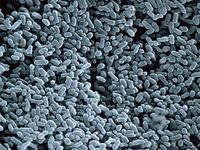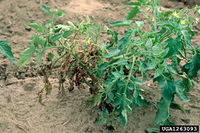Difference between revisions of "Clavibacter michiganensis"
| (22 intermediate revisions by the same user not shown) | |||
| Line 1: | Line 1: | ||
| − | {{ | + | {{TaxLinks|LnkClavibacter}} |
| − | {{ | + | {{LiteratureDBX|{{PAGENAME}}|1877|browse,Ccountrylnk,Pcrops,AbenefialsA}} |
| − | [[File: | + | [[File:Clavibacter michiganensis PlantDis 2021.jpg|350px|thumb|symptoms of ''Clavibacter michiganensis'' infection on tomato (click on image to enlarge it)<br/>Author(s): F. Christopher Peritore-Galve et al.<br/>Source: [https://dx.doi.org/10.1094/PDIS-08-20-1732-FE Plant Disease (2021) vo. 105 (6), art. 1732]]] |
| − | <font color="#800000">'''''Clavibacter michiganensis'''''</font> (Smith) Davis et al. | + | <font color="#800000">'''''Clavibacter michiganensis'''''</font> (Smith 1910) Davis et al. 1984 |
| − | + | ||
| − | + | This bacterium is wide-spread, Gram-positive, non-sporulating and causes several important crop diseases, mainly in temperate areas. The cells are rod-like and about 0.5-1.0 µm long. It spreads through small wounds and is easily transmitted through farming tools or seeds. It invades the xylem vessels of the host plant, causing wilts, cankers and rots. | |
| − | + | ||
| − | '' | + | ''C. michiganensis'' survives for several months in plant residues or seeds. Management methods include the use of uninfected seeds or plant materials and chemical control. Several subspecies of this bacterium have been described which cause diseases on specific crops. The two most important ones are: |
| − | + | ||
| − | + | '''•''' '''''Clavibacter michiganensis'' subsp. ''michiganensis''''' (Smith) Davis et al. causes '''bacterial canker of tomatoes''' which is characterized by wilting and canker lesions on the stem. Other symptoms are clearly defined brown leaf spots or leaf curling. Fruits may have "bird's eye spots" which are raised areas with a dark centre and a white halo. Plants may survive but yield will be reduced. Latent infections are also common. This subspecies has quarantine status in some countries. For a review on the identification and biology of this form see the [[EPPO Bulletin (2016) 46, 202-225|EPPO Bulletin (2016)]]. | |
| − | '' | + | |
| − | ''Clavibacter michiganensis'' subsp. '' | + | |
| − | '' | + | |
{{VN | {{VN | ||
| − | |de=Bakterielle Tomatenwelke | + | |de=Bakterielle Tomatenwelke |
| − | |en= | + | |en=tomato bacterial canker<br/>bacterial canker of tomato |
|es=marchitez bacteriana | |es=marchitez bacteriana | ||
| − | |fr=chancre bactérien | + | |fr=chancre bactérien |
}} | }} | ||
| + | '''Other subspecies are:'''<br /> | ||
| + | '''•''' ''Clavibacter michiganensis'' subsp. ''capsici'' see ''Clavibacter capsici''<br/> | ||
| + | '''•''' ''Clavibacter michiganensis'' subsp. ''insidiosus'' see ''[[Clavibacter insidiosus]]''<br/> | ||
| + | '''•''' ''Clavibacter michiganensis'' subsp. ''nebraskensis'' see ''[[Clavibacter nebraskensis]]''<br/> | ||
| + | '''•''' ''Clavibacter michiganensis'' subsp. ''sepedonicus'' see ''[[Clavibacter sepedonicus]]''<br/> | ||
| + | '''•''' ''Clavibacter michiganensis'' subsp. ''tesselarius'' - causes leaf spots in wheat. | ||
| + | |||
'''Synonyms:'''<br/> | '''Synonyms:'''<br/> | ||
''Corynebacterium michiganense'' | ''Corynebacterium michiganense'' | ||
| − | |||
| − | |||
| − | |||
<gallery widths=200px caption="Other images of Clavibacter michiganensis (IPM Images and PaDIL - click to enlarge)"> | <gallery widths=200px caption="Other images of Clavibacter michiganensis (IPM Images and PaDIL - click to enlarge)"> | ||
| + | File:Clavibacter_michiganensis_PaDIL136654a.jpg|cells | ||
File:Clavibacter_michiganensis_IPM1263093.jpg|wilt symptoms on tomato | File:Clavibacter_michiganensis_IPM1263093.jpg|wilt symptoms on tomato | ||
File:Clavibacter_michiganensis_IPM5368890.jpg|pith decay symptoms on tomato stem | File:Clavibacter_michiganensis_IPM5368890.jpg|pith decay symptoms on tomato stem | ||
| − | |||
| − | |||
</gallery> | </gallery> | ||
[[Category:Clavibacter (genus)]] | [[Category:Clavibacter (genus)]] | ||
Latest revision as of 22:21, 26 April 2022
| Literature database |
|---|
| 194 articles sorted by: |
| • year (descending) |
| • research topics |
| • countries/regions |
| • host plants |
| • list of antagonists |

Author(s): F. Christopher Peritore-Galve et al.
Source: Plant Disease (2021) vo. 105 (6), art. 1732
Clavibacter michiganensis (Smith 1910) Davis et al. 1984
This bacterium is wide-spread, Gram-positive, non-sporulating and causes several important crop diseases, mainly in temperate areas. The cells are rod-like and about 0.5-1.0 µm long. It spreads through small wounds and is easily transmitted through farming tools or seeds. It invades the xylem vessels of the host plant, causing wilts, cankers and rots.
C. michiganensis survives for several months in plant residues or seeds. Management methods include the use of uninfected seeds or plant materials and chemical control. Several subspecies of this bacterium have been described which cause diseases on specific crops. The two most important ones are:
• Clavibacter michiganensis subsp. michiganensis (Smith) Davis et al. causes bacterial canker of tomatoes which is characterized by wilting and canker lesions on the stem. Other symptoms are clearly defined brown leaf spots or leaf curling. Fruits may have "bird's eye spots" which are raised areas with a dark centre and a white halo. Plants may survive but yield will be reduced. Latent infections are also common. This subspecies has quarantine status in some countries. For a review on the identification and biology of this form see the EPPO Bulletin (2016).
| Vernacular names | |
|---|---|
| • Deutsch: | Bakterielle Tomatenwelke |
| • English: | tomato bacterial canker bacterial canker of tomato |
| • Español: | marchitez bacteriana |
| • Français: | chancre bactérien |
Other subspecies are:
• Clavibacter michiganensis subsp. capsici see Clavibacter capsici
• Clavibacter michiganensis subsp. insidiosus see Clavibacter insidiosus
• Clavibacter michiganensis subsp. nebraskensis see Clavibacter nebraskensis
• Clavibacter michiganensis subsp. sepedonicus see Clavibacter sepedonicus
• Clavibacter michiganensis subsp. tesselarius - causes leaf spots in wheat.
Synonyms:
Corynebacterium michiganense
- Other images of Clavibacter michiganensis (IPM Images and PaDIL - click to enlarge)


